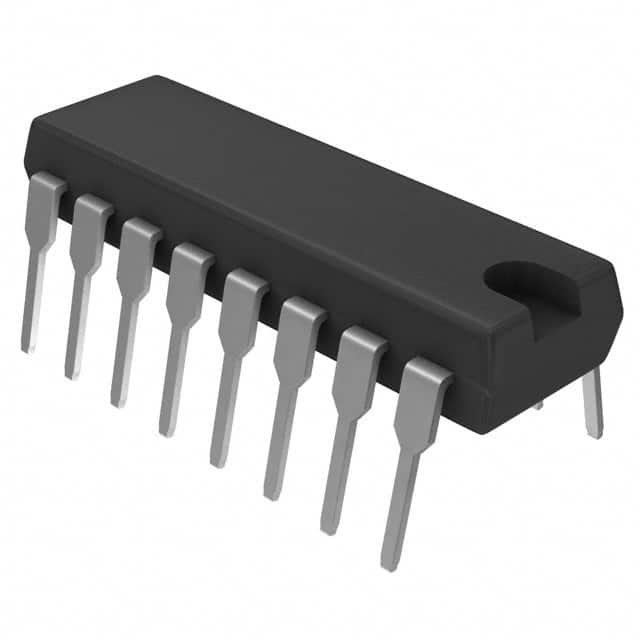Viz Specifikace pro podrobnosti o produktu.

CD4028BEG4
Product Overview
Category
CD4028BEG4 belongs to the category of integrated circuits (ICs).
Use
This IC is commonly used in digital electronics for various applications such as counting, decoding, and multiplexing.
Characteristics
- CD4028BEG4 is a 4-bit binary-to-decimal decoder.
- It has a wide operating voltage range of 3V to 18V.
- The IC is designed to be compatible with both TTL and CMOS logic levels.
- It offers high noise immunity and low power consumption.
- CD4028BEG4 is known for its reliable performance and durability.
Package
The CD4028BEG4 IC is available in a standard 16-pin dual in-line package (DIP). This package provides easy mounting and soldering onto printed circuit boards (PCBs).
Essence
The essence of CD4028BEG4 lies in its ability to convert a 4-bit binary input into a corresponding decimal output. It simplifies the process of decoding binary data and enables efficient control of various digital systems.
Packaging/Quantity
CD4028BEG4 is typically packaged in reels or tubes, containing a quantity of 250 or 1000 units per package, respectively.
Specifications
- Supply Voltage: 3V to 18V
- Input Voltage: 0V to VDD
- Output Voltage: 0V to VDD
- Operating Temperature Range: -55°C to +125°C
- Maximum Power Dissipation: 500mW
Detailed Pin Configuration
The CD4028BEG4 IC consists of 16 pins, each serving a specific function:
- A0: Binary input bit 0
- A1: Binary input bit 1
- A2: Binary input bit 2
- A3: Binary input bit 3
- VSS: Ground (0V)
- E: Enable input
- LT: Lamp test input
- BI/RBO: Ripple blanking output/ripple blanking input
- RBO: Ripple blanking output
- CARRY-OUT: Carry-out output
- CARRY-IN: Carry-in input
- BCD-1: Decimal output bit 1
- BCD-2: Decimal output bit 2
- BCD-3: Decimal output bit 3
- BCD-4: Decimal output bit 4
- VDD: Supply voltage
Functional Features
- CD4028BEG4 can decode a 4-bit binary input into one of ten decimal outputs.
- It provides a carry-out signal for cascading multiple ICs in larger systems.
- The enable input allows for control over the decoding operation.
- The lamp test input facilitates testing and debugging of the IC.
- Ripple blanking inputs and outputs enable synchronization with other components.
Advantages and Disadvantages
Advantages
- Wide operating voltage range allows for compatibility with various systems.
- High noise immunity ensures reliable performance even in noisy environments.
- Low power consumption contributes to energy efficiency.
- Compact package enables easy integration into circuit designs.
Disadvantages
- Limited to 4-bit binary-to-decimal decoding, not suitable for higher bit counts.
- Requires external components for more complex applications.
- May be sensitive to electrostatic discharge (ESD) if proper precautions are not taken during handling.
Working Principles
CD4028BEG4 operates based on the principles of combinational logic. It uses internal circuitry to convert the binary input into a corresponding decimal output. The enable input controls the decoding process, while the carry-in and carry-out signals facilitate cascading multiple ICs for larger counting applications.
Detailed Application Field Plans
CD4028BEG4 finds application in various digital systems, including but not limited to: - Digital counters - Multiplexers - Data encoding and decoding circuits - Seven-segment display drivers - Address decoders
Detailed and Complete Alternative Models
Some alternative models that offer similar functionality to CD4028BEG4 include: - CD4511: BCD-to-seven-segment decoder/driver - 74HC238: 3-to-8 line decoder/demultiplexer - CD4017: Decade counter/divider with 10 decoded outputs
These alternatives can be considered based on specific requirements and compatibility with the overall system design.
Word count: 570 words
Seznam 10 běžných otázek a odpovědí souvisejících s aplikací CD4028BEG4 v technických řešeních
Sure! Here are 10 common questions and answers related to the application of CD4028BEG4 in technical solutions:
Q: What is CD4028BEG4? A: CD4028BEG4 is a BCD-to-decimal decoder integrated circuit (IC) that converts binary-coded decimal (BCD) input into a corresponding decimal output.
Q: What are the typical applications of CD4028BEG4? A: CD4028BEG4 is commonly used in digital systems, such as calculators, digital clocks, electronic counters, and other devices that require BCD-to-decimal decoding.
Q: How many inputs does CD4028BEG4 have? A: CD4028BEG4 has four BCD input pins (A, B, C, D) and three control inputs (LT, ENP, ENT).
Q: What is the purpose of the LT pin in CD4028BEG4? A: The LT (Lamp Test) pin is used to test the display by lighting all the segments simultaneously when connected to ground.
Q: How does CD4028BEG4 handle invalid BCD inputs? A: CD4028BEG4 ignores any invalid BCD inputs (inputs greater than 9) and does not produce any output for those inputs.
Q: Can CD4028BEG4 drive common cathode or common anode displays? A: CD4028BEG4 can drive either common cathode or common anode displays, depending on the connection configuration.
Q: What is the maximum frequency at which CD4028BEG4 can operate? A: CD4028BEG4 can typically operate at frequencies up to 6 MHz.
Q: How many decimal outputs does CD4028BEG4 have? A: CD4028BEG4 has four decimal outputs (0, 1, 2, 3) that correspond to the BCD input.
Q: Can CD4028BEG4 be cascaded to decode larger BCD numbers? A: Yes, multiple CD4028BEG4 ICs can be cascaded together to decode larger BCD numbers.
Q: What is the power supply voltage range for CD4028BEG4? A: CD4028BEG4 typically operates with a power supply voltage range of 3V to 18V.
Please note that these answers are general and may vary depending on the specific datasheet and manufacturer's specifications for CD4028BEG4.

